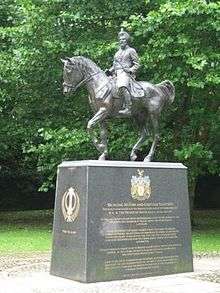Duleep Singh
Maharaja Duleep Singh (4 September 1838 – 22 October 1893), also known as His Highness Maharaja Sir Duleep Singh, GCSI, or Sir Dalip Singh[1] and later in life nicknamed the "Black Prince of Perthshire",[2] was the last Maharaja of the Sikh Empire. He was Maharaja Ranjit Singh's youngest son, the only child of Maharani Jind Kaur. [3]
| Maharaja Duleep Singh | |
|---|---|
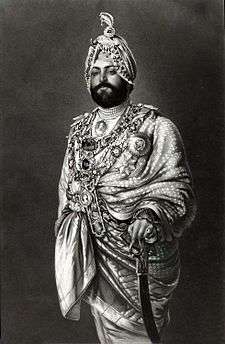 Maharaja Sir Duleep Singh in 1875, aged 37 | |
| 5th Maharaja of the Sikh Empire | |
| Reign | 15 September 1843 – 29 March 1849 |
| Predecessor | Sher Singh |
| Successor | Position Abolished |
| Regents | Maharani Jind Kaur |
| Wazir (Vizier) |
|
| Born | 4 September 1838 Lahore, Sikh Empire (present-day Punjab, Pakistan) |
| Died | 22 October 1893 (aged 55) Paris, French Third Republic (present-day France) |
| Spouse | Ada Douglas Wetherill
( m. after 1889) |
| Issue | By Bamba Müller:
By Ada Wetherill:
|
| Dynasty | Sandhanwalia |
| Father | Maharaja Ranjit Singh |
| Mother | Maharani Jind Kaur |
| Religion | Sikhism (1838—1853, 1886—1893) Anglicanism (1853—1886) |
He was placed in power in September 1843, at the age of five, with his mother ruling on his behalf, and after their defeat in the Sikh Anglo War, under a British Resident. He was subsequently kidnapped by the British Crown, and thereafter exiled to Britain at age 15 where he was befriended by Queen Victoria, who is reported to have written of the Punjabi Maharaja: "Those eyes and those teeth are too beautiful".[4] The Queen was godmother to several of his children.[5] He died young, living most of his final years in the United Kingdom.[6][7][8]
His mother had effectively ruled when he was very young and he managed to meet her again on 16 January 1861 in Calcutta and return with her to the United Kingdom.[9] During the last two years of her life, his mother told the Maharaja about his Sikh heritage and the Empire which once had been his to rule. In June 1861, he was first appointed as a Knight in the Order of the Star of India.
Early years
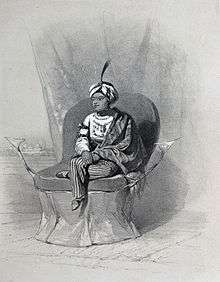
After the death of Maharaja Ranjit Singh in 1839, Duleep Singh lived quietly with his mother, Jind Kaur, at Jammu, under the protection of the Vizier, Raja Dhian Singh. He and his mother were recalled to Lahore in 1843 after the assassinations of Maharaja Sher Singh and Dhian Singh, and on 16 September, at the age of five, Duleep Singh was proclaimed Maharaja of the Sikh Empire, with Maharani Jind Kaur as Regent.
%2C_entering_his_palace_in_Lahore%2C_escorted_by_British_troops.jpg)
On 13 December 1845 the British declared war on the Sikhs and, after winning the First Anglo-Sikh War, retained the Maharaja as nominal ruler, but replaced the Maharani by a Council of Regency and later imprisoned and exiled her. Over thirteen years passed before Duleep Singh was permitted to see his mother again.
After the close of the Second Anglo-Sikh War and the subsequent annexation of the Punjab on 29 March 1849,[10] he was deposed at the age of ten[11] and was put into the care of Dr John Login and sent from Lahore to Fatehgarh on 21 December 1849, with tight restrictions on who he was allowed to meet. No Indians, except trusted servants, could meet him in private. As a matter of British policy, he was to be anglicised in every possible respect. His health was reportedly poor and he was often sent to the hill station of Landour near Mussoorie in the Lower Himalaya for convalescence, at the time about 4 days' journey. He would remain for weeks at a time in Landour at a grand hilltop building called The Castle, which had been lavishly furnished to accommodate him.
Conversion to Christianity
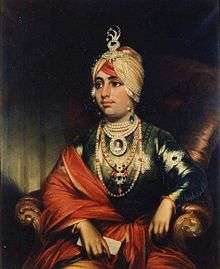
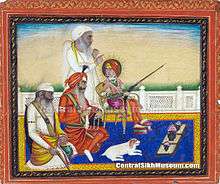
In 1853, under the tutelage of his long-time retainer Bhajan Lal (himself a Christian convert), he converted to Christianity at Fatehgarh with the approval of the Governor-General Lord Dalhousie. His conversion remains controversial, and it occurred before he turned 15. He later had serious doubts and regrets regarding this decision and reconverted to Sikhism in 1886.[12]
He was also heavily and continuously exposed to Christian texts under the tutelage of the devout Sir John Spencer Login. His two closest childhood friends were both English Anglican missionaries. In May 1854 he was sent into exile in Britain.
Life in exile
London
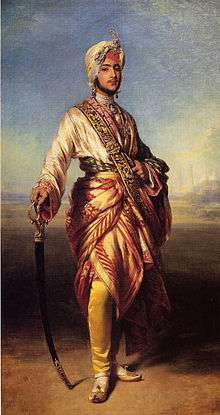
Duleep Singh's arrival on the shores of England in late 1854 threw him into the British court. Queen Victoria showered affection upon the turbaned Maharaja, as did the Prince Consort. Duleep Singh was initially lodged at Claridge's Hotel in London before the East India Company took over a house in Wimbledon and then eventually another house in Roehampton which became his home for three years. He was also invited by the Queen to stay with the Royal Family at Osborne, where she sketched him playing with her children and Prince Albert photographed him, while the court artist, Winterhalter, made his portrait.[13]
He eventually got bored with Roehampton and expressed a wish to go back to India but it was suggested by the East India Company Board he take a tour of the European continent which he did with Sir John Spencer Login and Lady Login. He was a member of the Photographic Society, later the Royal Photographic Society, from 1855 until his death.[14]
Castle Menzies
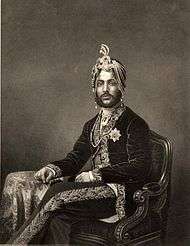
On his return from Continental Europe in 1855 he was given an annual pension, and was officially under ward of Sir John Spencer Login and Lady Login, who leased Castle Menzies in Perthshire, Scotland, for him. He spent the rest of his teens there but at 19 he demanded to be in charge of his household. Eventually, he was given this and an increase in his annual pension.
In 1859 Lt Col James Oliphant was installed as Equerry to the Maharaja at the recommendation of Sir John Login. Oliphant was to be a possible replacement should anything happen to the Maharaja's most trusted friend Sir John Login (who did indeed die four years later in 1863).[15]
Reunion with his mother
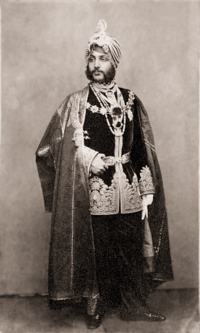
When he was 18, Singh wrote to his mother in Kathmandu, suggesting that she should join him in Great Britain, but his letter was intercepted by the British in India and did not reach her. He then sent a courier, Pundit Nehemiah Goreh, who was also intercepted and forbidden to contact the Maharani. Duleep Singh then decided to go himself. Under cover of a letter from Login he wrote to the British Resident in Kathmandu, who reported that the Maharani had 'much changed, was blind and had lost much of the energy which formerly characterised her.' The British decided she was no longer a threat and she was allowed to join her son on 16 January 1861 at Spence’s Hotel in Calcutta and return with him to England.[16]
Auchlyne and Aberfeldy
In 1858 the lease of Castle Menzies expired and Duleep Singh rented the house at Auchlyne from the Earl of Breadalbane. He was known for a lavish lifestyle, shooting parties, and a love of dressing in Highland costume and soon had the nickname "the Black Prince of Perthshire".[17] (At the same time, he was known to have gradually developed a sense of regret for his circumstances in exile, including some inner turmoil about his conversion to Christianity and his forced departure from the Punjab). His mother stayed in Perthshire with him for a short time, before he rented the Grantully Estate, near Aberfeldy. Following the deaths of his mother and Sir John Login in 1863, he returned to England.[18]
Elveden Estate
Maharaja Duleep Singh (as he became in June 1861) bought (or the India Office purchased for him) a 17,000 acre (69 km²) country estate at Elveden on the border between Norfolk and Suffolk, close to Thetford, in 1863. He enjoyed living in Elveden Hall and the surrounding area and restored the church, cottages, and school. He transformed the run-down estate into an efficient game preserve of approximately 17,000 acres (69 km2) and it was here that he gained his reputation as the fourth best shot in England.[19][20][21]
The house was remodelled into a quasi-oriental palace where he lived the life of a British aristocrat.[22] Maharaja Duleep Singh was accused of running up large expenses and the estate was sold after his death to pay his debts. Today, Elveden is owned by The 4th Earl of Iveagh, the head of the Anglo-Irish Guinness family of brewing fame; it remains an operating farm and private hunting estate.
Re-initiated into Sikhism
While in exile, he sought to learn more about Sikhism and was eager to return to India. Though previous efforts were thwarted by his handlers, he reestablished contact with his cousin Sardar Thakar Singh Sandhawalia, who on 28 September 1884 left Amritsar for England along with his sons Narinder Singh and Gurdit Singh and a Sikh granthi (priest), Pratap Singh Giani. He also brought a list of properties held by Sir Duleep Singh in India. All this renewed his connection with Sikhism.[23]
The British Government decided in 1886 against his return to India or his re-embracing Sikhism. Despite protests from the India Office, he set sail for 'home' on 30 March 1886. However, he was intercepted and arrested in Aden, then part of Aden Settlement, where the writ of the Viceroy of India began. He could not be stopped from an informal re-conversion ceremony in Aden, far less grand and symbolic than it would have been in India, done by emissaries sent by Sardar Thakar Singh Sandhawalia, who was earlier planning the Pahaul ceremony at Bombay.[23] Sir Duleep was forced to return to Europe.
Death
Maharaja Duleep Singh died in Paris in 1893 at the age of 55, having seen India after the age of fifteen during only two brief, tightly controlled visits in 1860 (to bring his mother to England) and in 1863 (to cremate his mother's body).
Maharaja Duleep Singh's wish for his body to be returned to India was not honoured, in fear of unrest, given the symbolic value the funeral of the son of the Lion of the Punjab might have caused and the growing resentment of British rule. His body was brought back to be buried according to Christian rites, under the supervision of the India Office, in Elveden Church beside the grave of his wife Maharani Bamba, and his son Prince Edward Albert Duleep Singh. The graves are located on the west side of the Church.
A life-size bronze statue of the Maharaja, showing him on a horse, was unveiled by H.R.H. The Prince of Wales in 1999 at Butten Island in Thetford, a town which benefited from his and his sons' generosity.[5][24]
In an auction at Bonhams, London, on 19 April 2007, the 74 cm high white marble portrait bust of Maharaja Duleep Singh by Victorian sculptor John Gibson, R.A., in Rome in 1859[25] fetched £1.7 million (£1.5 million plus premium and tax).[26][27]
A film titled Maharaja Duleep Singh: A Monument Of Injustice, was made in 2007, directed by P.S. Narula.[28]
Heraldry
A coat of arms was granted, commissioned by Prince Albert.
Family
Sir Duleep Singh married twice, first to Bamba Müller in 1864 Alexandria, and then to Ada Douglas Wetherill, in 1889. He had eight children in total.
He had six children from his marriage to Bamba:
- Prince Victor Albert Jay Duleep Singh (10 Jan 1866-7 Jun 1918)
- Prince Frederick Victor Duleep Singh (23 Jan 1868-15 Aug 1926)
- Princess Bamba Sophia Jindan Duleep Singh (29 Sep 1869-10 Mar 1957)
- Princess Catherine Hilda Duleep Singh[29] (27 Oct 1871-8 Nov 1942)
- Princess Sophia Alexandra Duleep Singh (8 Aug 1876-22 Aug 1948)
- Prince Albert Edward Duleep Singh (1879-1 May 1893)
He also had two children from his marriage to Wetherill:
- Princess Pauline Alexandra Duleep Singh (26 Dec 1887-10 Apr 1941)
- Princess Ada Irene Beryl Duleep Singh (25 Oct 1889-14 Sep 1926)
All the eight children died without legitimate issue, ending the direct line of the Sikh Royalty.[30]
There is a memorial at Eton College in England to Princes Victor and Frederick, Maharaja Sir Duleep Singh's two sons who studied at Eton in the 1870s.[4]
Maharani Bamba Müller
H.H. Maharani Bamba Müller was an Arabic-speaking, part-Ethiopian, part-German woman, whose father was a German banker and whose mother was an Abyssinian Coptic Christian slave. She and Sir Duleep met in Cairo in 1863 on his return from scattering his mother's ashes in India; they were married in Alexandria, Egypt, on 7 June 1864. The Maharani died in London on 18 September 1887.
Ada Douglas Wetherill
Some sources describe Ada Douglas Wetherill as a French princess. In fact, she was neither French nor a princess. This is very likely a fiction created to give her some legitimacy later in life. Wetherill had been Duleep's mistress before he decided to return to India with his family, and upon being stopped in Aden by the British authorities he abandoned his family and moved to Paris, where she joined him. She stayed with him through his years in Paris and also travelled with him to St. Petersburg, Russia, where he failed to persuade the Czar of the benefits of invading India through the north and reinstalling him as ruler.[31]
Queen Victoria and Maharaja Duleep Singh reconciled their differences before he died. Out of loyalty to Maharani Bamba, the Queen refused to receive Ada, who she suspected had been involved with the Maharaja before Maharani Bamba's death in 1887.[32]
Miscellany
In 1854, Madame Blavatsky, the founder of Theosophical Society, met her Master Morya in England, who was in her words, "in the company of a dethroned native prince". This "native prince" according to general consent was Sir Duleep Singh. [33]
He was a member of the Freemasons and was admitted into the lodge in 1861.[34][35]
On 21st October 1893, the day before Sir Duleep Singh's death, Prince Victor Duleep Singh, the eldest son of Sir Duleep Singh, had visions of his father looking at him through a picture frame. [36]
Duleep Singh remembered his servant with gravestone in Killin cemetery, Killin, Scotland. [37]
Further reading
- Sikh History in 10 Volumes, by Dr Harjinder Singh Dilgeer. Published by Sikh University Press, Belgium, 2009-2012.
- Sir John Login And Duleep Singh, by Lady Lena Login. W. H. Allen & Co., London. 1890.
- Maharaja Duleep Singh Correspondence, by Dhuleep Singh, Ganda Singh. Published by Punjabi University, 1977.
- Sikh Portraits by European Artists,, by Aijazuddin, F.S. Sotheby Parke Bernet, London and Oxford U. Press, Karachi and New Delhi, 1979.
- The Duleep Singh's: The Photograph Album of Queen Victoria's Maharajah, by Peter Bance (Bhupinder Singh Bance). Sutton Publishing, ISBN 0-7509-3488-3
- The Maharajah's Box: An Imperial Story of Conspiracy, Love and a Guru's Prophecy, by Campbell, Christy. Harper Collins, ISBN 0-00-653078-8 The Maharaja's Box
- Queen Victoria's Maharajah, Duleep Singh, 1838–93, by Michael Alexander and Sushila Anand. 1980. ISBN 1-84212-232-0, ISBN 978-1-84212-232-7
- Duleep Singh: The Maharaja of Punjab and the Raj, by Rishi Ranjan Chakrabarty. Published by D.S. Samara, 1988. ISBN 0-9514957-0-4.
- Maharaja Duleep Singh: The Last Sovereign Ruler of the Punjab, by Prithipal Singh Kapur. Published by Shiromani Gurudwara Parbandhak Committee, Dharam Parchar Committee, 1995.
- Maharaja Duleep Singh, Fighter for Freedom, by Baldev Singh Baddan. Published by National Book Shop, 1998. ISBN 81-7116-210-X.
- Maharaja Daleep Singh, by Balihar Singh Randhawa. Sikh Literary & Cultural Stall, 1998. ISBN 1-900860-01-5.
- The Maharajah Duleep Singh and the Government: A Narrative, by Surjit Singh Jeet. Published by Guru Nanak Dev University, 1999.
- The Annexation of the Punjaub, and the Maharajah Duleep Singh, by Thomas Evans Bell. Adamant Media Corporation, 2001. ISBN 0-543-92432-7.
- Maharaja Dalip Singh Cheated Out, by Avtar Singh Gill. Jaswant Printers. 2007[38]
- The Exile, by Navtej Sarna. Penguin, 2008. ISBN 978-0-670-08208-7.[39]
- Sovereign, Squire & Rebel: Maharajah Duleep Singh and the heirs of a Lost Kingdom, by Peter Bance, Coronet House Publishing, London, 2009
References
- His name has several alternative spellings. Among them are Dhulip, Dulip, Dhalip, Dhuleep and Dalip, but he used Duleep when writing it himself, although Dalip is the conventional spelling for the Punjabi name. Official British letters and documents sometimes refer to him as Dalip the Ultimate.
- Dalip Singh – website Britannica.com
- "The Black Prince of Perthshire". The Scotsman. Retrieved 26 January 2017.
- Eton, the Raj and modern India; By Alastair Lawson; 9 March 2005; BBC News.
- Royal tribute to first Sikh settler BBC News, July 29, 1999.
- Freeman, Henry. East India Company, Beginning to End.
- Wild, Antony. East India Company: trade and Conquest.
- William, Dalrymple (4 March 2015). "The East India Company: The original corporate raiders". The Guardian. Retrieved 15 April 2019.
- E Dalhousie Login, Lady Login's Recollections, Chapter 14, Smith Elder, 1916
- The tragic life of Maharaja Dalip Singh By Reeta Sharma, The Tribune, February 20, 1999
- Duleep Singh Archived July 13, 2009, at the Wayback Machine www.collectbritain.co.uk.
- Campbell, Christy (2008). The Maharajah's Box. Harper Collins. p. 100. ISBN 0 00 653078 8.
- Maharaja Dalip Singh in London Archived July 29, 2008, at the Wayback Machine Victoria & Albert Museum.
- http://rpsmembers.dmu.ac.uk/rps_results.php?mid=540 Accessed 6 July 2014
- Sir John Login and Duleep Singh
- Login, Lady Lena Campbell (1916). "Lady Login's Recollections". California Digital Library. Smith, Elder & Co. pp. 207, 208 (Chapter XIV). Retrieved 18 July 2014.
- On the trail of the Sikh heritage BBC News, September 30, 2008.
- "The 'Black Prince' of Perthshire", Highlander Web Archived February 24, 2005, at the Wayback Machine
- Michael Alexander and Sushila Anand. Queen Victoria's Maharaja: Duleep Singh 1838–93 ISBN 1-84212-232-0, ISBN 978-1-84212-232-7
- http://www.fieldsportsmagazine.com/articles_shoot_how_good_were_they.php
- Edwards, Adam (13 October 2001). "All guns blazing". The Daily Telegraph. London.
- http://www.britishlistedbuildings.co.uk/en-275758-elveden-hall-elveden
- He prepared the exiled Maharaja to seek to wrest back his lost empire The Tribune, September 21, 2002.
- Duleep Singh Statue Archived March 4, 2007, at the Wayback Machine
- Prince charming of Punjab heads up art sale The Times, March 14, 2007.
- Sikh hero bust is sold for £1.7m BBC News, April 20, 2007.
- bust of Duleep Singh went for 1.7 million pounds in 2007 Archived December 8, 2008, at the Wayback Machine Hindustan Times', October 07, 2008.
- Maharaja Duleep Singh: A Monument Of Injustice (DVD) Archived July 12, 2009, at the Wayback Machine
- The Swiss Account of Princess Catherine Duleep Singh The Tribune, June 25, 2001.
- The lives and times of three generations of India princesses. Edited by Peter Bance Archived July 13, 2009, at the Wayback Machine Navtej Sarna
- Russia’s onward march; progress in Asia and India is her goal. Native Indians who may help her-- the story of Duleep Singh’s going to Russia. The New York Times, October 9, 1887.
- Michael Alexander and Sushila Anand. Queen Victoria's Maharajah: Duleep Singh 1838–93 ISBN 1-84212-232-0, ISBN 978-1-84212-232-7.
- Blavatsky, Helena. Blavatsky Collected Writings Online.
- http://www.freemasonrytoday.com/features/the-life-of-a-british-maharaja
- http://www.masonindia.in/index.php/some-very-well-known-indian-freemasons/
- Barrett, William. Occultism and common-sense.
- Killin News Apr 1998, P3
- Maharaja Dalip Singh Cheated Out – Book Review The Tribune, November 25, 2007.
- The Exile: A Maharaja's tragic journey Rediff.com, 15 October 2008.
External links
| Wikimedia Commons has media related to Duleep Singh. |
- Duleep Singh Website
- Gallery of Rare pics of Maharaja Duleep Singh
- Genealogy of Lahore (Princely State) Queensland University
- Anglo Sikh Heritage Trail
- Maharajah Duleep Singh, Biography and Images Norfolk Museum and Archeology Service
- Video links
| Regnal titles | ||
|---|---|---|
| Preceded by Sher Singh |
Maharaja of the Sikh Empire 1843–1849 |
Succeeded by British Raj |
